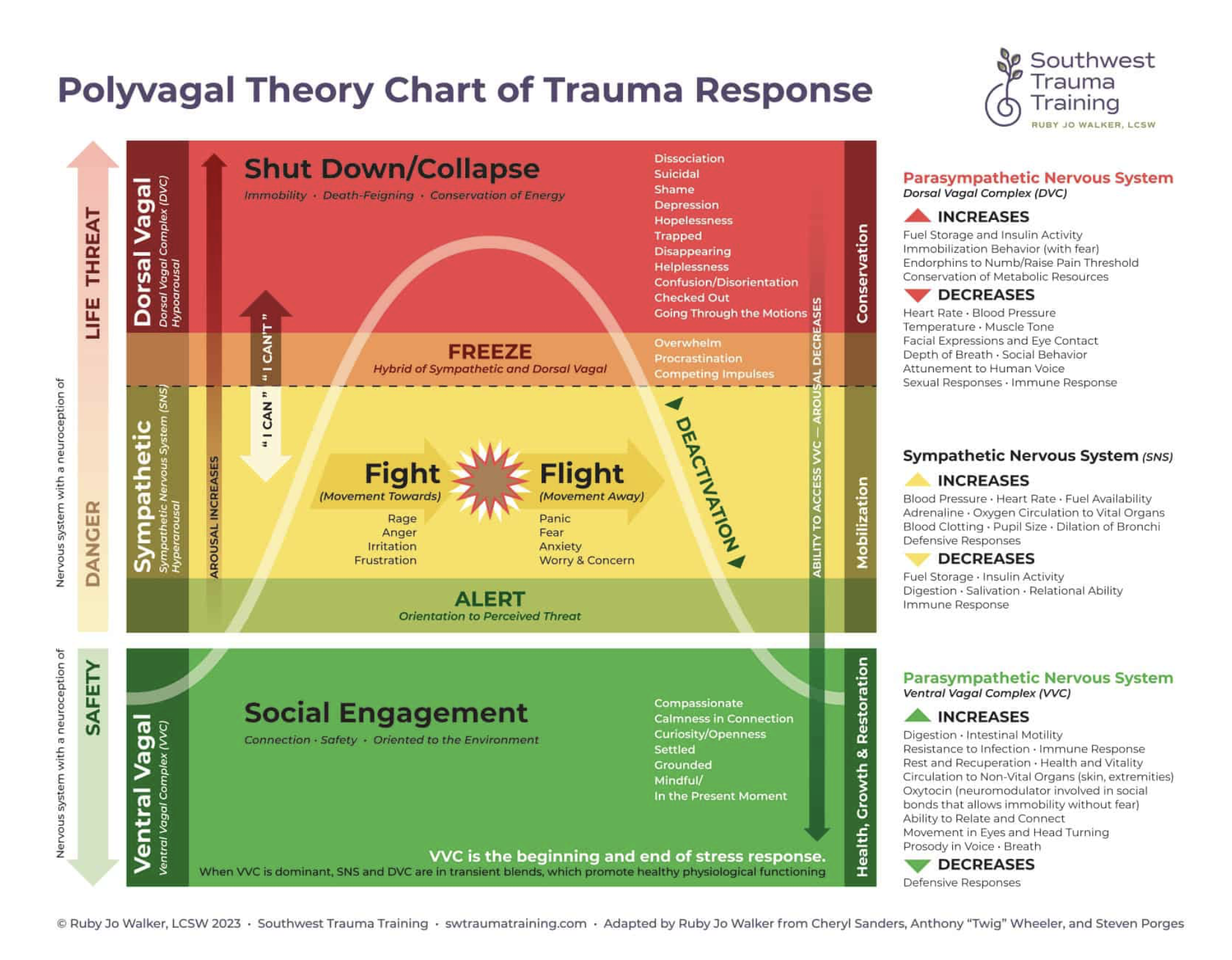Understanding Polyvagal Theory: How Your Nervous System Responds to Stress and Trauma
If you’ve ever wondered why your body reacts so strongly to stress or why you sometimes feel shut down or disconnected, Polyvagal Theory offers a way to make sense of these experiences and shows us that our body’s responses are rooted in survival, not weakness. Developed by Dr. Stephen Porges and applied in therapy by clinicians like Deb Dana and Peter Levine, this approach shows us how the nervous system shapes trauma responses and how we can work with it to heal.
The Role of the Vagus Nerve
The vagus nerve is like a communication superhighway, running from your brain down through your body and connecting to your heart, lungs, and digestive system. Its job is to help regulate how safe or threatened you feel.
Polyvagal theory describes three main “states” of the nervous system:
- Ventral vagal (safety and connection): You feel calm, grounded, and able to connect with others.
- Sympathetic activation (mobilization): Your body prepares for fight or flight—helpful in danger, but overwhelming when stuck here.
- Dorsal vagal (shutdown): When things feel too overwhelming, the body may shut down, leaving you feeling numb, disconnected, or collapsed.
Dorsal Vagal Shutdown
Dorsal vagal shutdown is the body’s way of saying, “This is too much, I need to power down to survive.” It can look like spacing out, feeling cut off from emotions, or being unable to engage. While protective in the moment, it can feel frightening or shameful when it lingers after the danger is over.
Understanding this state as your nervous system’s survival strategy—not a weakness—can be deeply healing.
Polyvagal Therapy and Trauma Work
Polyvagal-informed therapy pays attention to your body as much as your thoughts. In addition to exploring your thoughts, therapy also focuses on what your body is experiencing.
Some helpful practices include:
- Mapping your states: Learning to notice when you’re in safety, fight/flight, or shutdown.
- Co-regulation: Using safe connection with another person—like your therapist—to help shift back toward safety.
- Somatic tools: Breathing, grounding, or gentle movement to remind the body it is safe.
- Trauma processing approaches: Methods like Somatic Experiencing (Levine, 2010) or polyvagal-informed therapy (Dana, 2018) work directly with these body states to release survival energy and restore balance.
Window of Tolerance Language
Some clients may already be familiar with the Window of Tolerance model, which uses slightly different words but overlaps closely with Polyvagal Theory. When using the Window of Tolerance, these nervous system states are described as:
- Hyperarousal: Feeling anxious, panicky, or “amped up” (similar to sympathetic activation). (SYMPATHETIC ACTIVATION).
- In the Window: Feeling collected, able to engage and think effectively. (VENTRAL VAGAL)
- Hypoarousal: Feeling numb, frozen, or disconnected (similar to dorsal vagal shutdown). (DORSAL VAGAL)
Visual: The Polyvagal Theory Chart
Ruby Jo Walker created a chart based on Stephen Porges’ work that illustrates how the nervous system responds to trauma and stress. This visual can be a helpful tool for putting it all together (and it may be helpful to review this and/or the Window of Tolerance with your therapist!)

Final Thoughts
Trauma lives not only in the mind but also in the body. By understanding how the vagus nerve and nervous system respond to stress, therapy can help you move from survival states into greater safety, connection, and resilience. Polyvagal-informed approaches offer both a language and a roadmap for healing.
References
Dana, D. (2018). The polyvagal theory in therapy: Engaging the rhythm of regulation. W. W. Norton & Company.
Levine, P. A. (2010). In an unspoken voice: How the body releases trauma and restores goodness. North Atlantic Books.
Porges, S. W. (2011). The polyvagal theory: Neurophysiological foundations of emotions, attachment, communication, and self-regulation. W. W. Norton & Company.
Walker, R. J. (2020). Polyvagal theory chart of trauma response [Chart]. Retrieved from https://www.rubyjowalker.com
